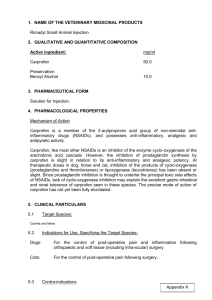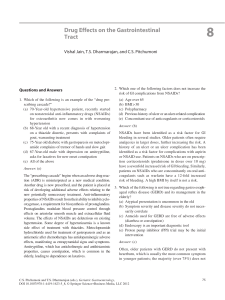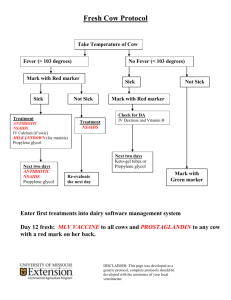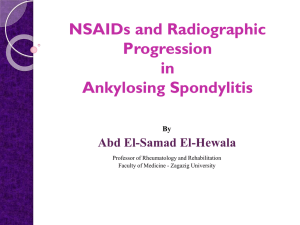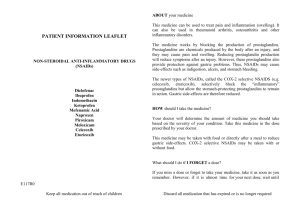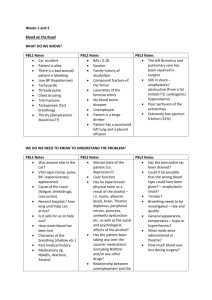Non-steroidal anti-inflammatory drugs
advertisement
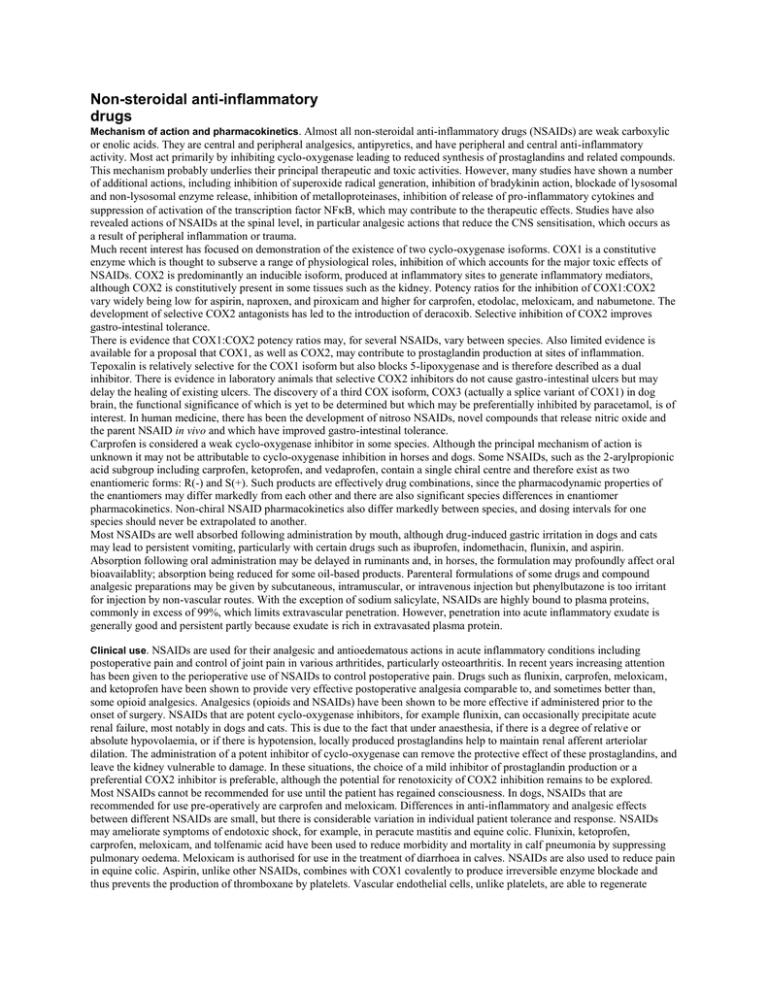
Non-steroidal anti-inflammatory drugs Mechanism of action and pharmacokinetics. Almost all non-steroidal anti-inflammatory drugs (NSAIDs) are weak carboxylic or enolic acids. They are central and peripheral analgesics, antipyretics, and have peripheral and central anti-inflammatory activity. Most act primarily by inhibiting cyclo-oxygenase leading to reduced synthesis of prostaglandins and related compounds. This mechanism probably underlies their principal therapeutic and toxic activities. However, many studies have shown a number of additional actions, including inhibition of superoxide radical generation, inhibition of bradykinin action, blockade of lysosomal and non-lysosomal enzyme release, inhibition of metalloproteinases, inhibition of release of pro-inflammatory cytokines and suppression of activation of the transcription factor NFB, which may contribute to the therapeutic effects. Studies have also revealed actions of NSAIDs at the spinal level, in particular analgesic actions that reduce the CNS sensitisation, which occurs as a result of peripheral inflammation or trauma. Much recent interest has focused on demonstration of the existence of two cyclo-oxygenase isoforms. COX1 is a constitutive enzyme which is thought to subserve a range of physiological roles, inhibition of which accounts for the major toxic effects of NSAIDs. COX2 is predominantly an inducible isoform, produced at inflammatory sites to generate inflammatory mediators, although COX2 is constitutively present in some tissues such as the kidney. Potency ratios for the inhibition of COX1:COX2 vary widely being low for aspirin, naproxen, and piroxicam and higher for carprofen, etodolac, meloxicam, and nabumetone. The development of selective COX2 antagonists has led to the introduction of deracoxib. Selective inhibition of COX2 improves gastro-intestinal tolerance. There is evidence that COX1:COX2 potency ratios may, for several NSAIDs, vary between species. Also limited evidence is available for a proposal that COX1, as well as COX2, may contribute to prostaglandin production at sites of inflammation. Tepoxalin is relatively selective for the COX1 isoform but also blocks 5-lipoxygenase and is therefore described as a dual inhibitor. There is evidence in laboratory animals that selective COX2 inhibitors do not cause gastro-intestinal ulcers but may delay the healing of existing ulcers. The discovery of a third COX isoform, COX3 (actually a splice variant of COX1) in dog brain, the functional significance of which is yet to be determined but which may be preferentially inhibited by paracetamol, is of interest. In human medicine, there has been the development of nitroso NSAIDs, novel compounds that release nitric oxide and the parent NSAID in vivo and which have improved gastro-intestinal tolerance. Carprofen is considered a weak cyclo-oxygenase inhibitor in some species. Although the principal mechanism of action is unknown it may not be attributable to cyclo-oxygenase inhibition in horses and dogs. Some NSAIDs, such as the 2-arylpropionic acid subgroup including carprofen, ketoprofen, and vedaprofen, contain a single chiral centre and therefore exist as two enantiomeric forms: R(-) and S(+). Such products are effectively drug combinations, since the pharmacodynamic properties of the enantiomers may differ markedly from each other and there are also significant species differences in enantiomer pharmacokinetics. Non-chiral NSAID pharmacokinetics also differ markedly between species, and dosing intervals for one species should never be extrapolated to another. Most NSAIDs are well absorbed following administration by mouth, although drug-induced gastric irritation in dogs and cats may lead to persistent vomiting, particularly with certain drugs such as ibuprofen, indomethacin, flunixin, and aspirin. Absorption following oral administration may be delayed in ruminants and, in horses, the formulation may profoundly affect oral bioavailablity; absorption being reduced for some oil-based products. Parenteral formulations of some drugs and compound analgesic preparations may be given by subcutaneous, intramuscular, or intravenous injection but phenylbutazone is too irritant for injection by non-vascular routes. With the exception of sodium salicylate, NSAIDs are highly bound to plasma proteins, commonly in excess of 99%, which limits extravascular penetration. However, penetration into acute inflammatory exudate is generally good and persistent partly because exudate is rich in extravasated plasma protein. Clinical use. NSAIDs are used for their analgesic and antioedematous actions in acute inflammatory conditions including postoperative pain and control of joint pain in various arthritides, particularly osteoarthritis. In recent years increasing attention has been given to the perioperative use of NSAIDs to control postoperative pain. Drugs such as flunixin, carprofen, meloxicam, and ketoprofen have been shown to provide very effective postoperative analgesia comparable to, and sometimes better than, some opioid analgesics. Analgesics (opioids and NSAIDs) have been shown to be more effective if administered prior to the onset of surgery. NSAIDs that are potent cyclo-oxygenase inhibitors, for example flunixin, can occasionally precipitate acute renal failure, most notably in dogs and cats. This is due to the fact that under anaesthesia, if there is a degree of relative or absolute hypovolaemia, or if there is hypotension, locally produced prostaglandins help to maintain renal afferent arteriolar dilation. The administration of a potent inhibitor of cyclo-oxygenase can remove the protective effect of these prostaglandins, and leave the kidney vulnerable to damage. In these situations, the choice of a mild inhibitor of prostaglandin production or a preferential COX2 inhibitor is preferable, although the potential for renotoxicity of COX2 inhibition remains to be explored. Most NSAIDs cannot be recommended for use until the patient has regained consciousness. In dogs, NSAIDs that are recommended for use pre-operatively are carprofen and meloxicam. Differences in anti-inflammatory and analgesic effects between different NSAIDs are small, but there is considerable variation in individual patient tolerance and response. NSAIDs may ameliorate symptoms of endotoxic shock, for example, in peracute mastitis and equine colic. Flunixin, ketoprofen, carprofen, meloxicam, and tolfenamic acid have been used to reduce morbidity and mortality in calf pneumonia by suppressing pulmonary oedema. Meloxicam is authorised for use in the treatment of diarrhoea in calves. NSAIDs are also used to reduce pain in equine colic. Aspirin, unlike other NSAIDs, combines with COX1 covalently to produce irreversible enzyme blockade and thus prevents the production of thromboxane by platelets. Vascular endothelial cells, unlike platelets, are able to regenerate cyclo-oxygenase, and so produce prostacyclin, which has an anti-aggregative effect. This action has been utilised to prevent platelet aggregation in thrombo-embolic disorders. The pharmacokinetics and pharmacodynamics of NSAIDs vary between species, leading to inter-species differences in dosage requirements. In general, the dosage interval should be increased in neonates and aged animals to avoid toxicity. Side-effects. Toxicity of NSAIDs varies with the species, the individual animal within the species, and the individual drug and is therefore not readily predictable. The main sideeffects of NSAIDs are gastro-intestinal irritation and ulceration, and renal failure. Lesions may occur throughout the gastro-intestinal tract and high doses may lead to a lifethreatening plasma protein-losing enteropathy in horses. Lesions may occur after parenteral or oral administration and may be more prevalent in patients given NSAIDs in conjunction with corticosteroids. Treatment includes the H2-antagonists ranitidine or cimetidine, the prostaglandin E1 analogue misoprostol, or ‘proton pump’ inhibitors such as omeprazole. NSAIDs can induce direct renal papillary necrosis, or renal failure if administered in dehydrated, hypovolaemic, or hypotensive animals. Other side-effects include vomiting, blood dyscrasias, delayed blood clotting, hepatotoxicity due to cholestatic and parenchymal cell damage, and occasionally skin rashes. Some NSAIDs, such as aspirin, have been shown to be teratogenic in animal studies. Some NSAIDs inhibit proteoglycan synthesis particularly when increased, for example, in osteoarthritis. However, carprofen increased proteoglycan synthesis in studies using equine and canine chondrocytes and explants in vitro and this drug has also reduced cartilage damage in an experimental model of osteoarthritis in dogs. There is relatively little difference between NSAIDs in terms of anti-inflammatory or analgesic efficacy, the choice of NSAID should therefore depend on the incidence of sideeffects associated with use of the drug. However, unfortunately, there is insufficient information on the clinical incidence of side-effects associated with NSAID use in animals.
